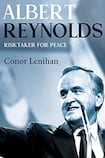
Of the things Albert Reynolds is known for – the self-made fortune, his role in the peace process – I confess that until I read this book I was totally unaware of his role in the bizarre events on Aer Lingus flight 164 in 1981. An Australian monk named Laurence Downey had hijacked the flight between Dublin and Heathrow, diverting it to Paris. His demand was the release of the so-called Third Secret of Fatima, claimed to be the last of three prophecies handed to children in Portugal in 1917, and in 1981 still being suppressed by the Vatican.
Into this surreal situation flew minister Albert Reynolds to act as a negotiator – and with some success; the situation ended peacefully with French police surrounding the hijacker while Reynolds chatted to him.
Though not a major part of this new book, the Downey story probably vindicates the title Conor Lenihan chose for it: Albert Reynolds: Risktaker for Peace. It is hard to imagine many politicians now, or even back then, willing to insert themselves into the middle of a hostage situation. Reynolds, as this book shows, demonstrated over and over again a preference for action, motion, intervention – in many cases to the public good, in other instances less so. His handling of state support for Larry Goodman’s beef empire – and particularly his handling of the tribunal that followed – is the most obvious example of the latter, but one on which Lenihan does not dwell for long in this book.
As is well known, Reynolds was a highly successful entrepreneur, but he is presented here as politician-as-entrepreneur, from day-to-day governance and party management to high-stakes peace negotiations. Opportunities were to be capitalised on and maximised through relationships of trust: a priest permitting the Reynolds brothers to run a dance in a hall; another priest providing a link to an IRA leadership ready for peace 40 years later.
That comparison isn’t meant to sound glib, or suggest that Reynolds viewed business deals in the same light as his grave role in ending the Troubles, but simply to acknowledge that he brought the same skills – energy, lack of dogma, charm – to them.
The ability to craft relationships, to be trusted, was a Reynolds hallmark. Personal relationships mattered more than abstraction or ideology. In this regard, he was fortunate to have as his counterpart John Major, another self-made pragmatist with little interest in abstraction. And of course, both shared the characteristic of having succeeded highly controversial – and more nationalistic – predecessors.
Reynolds’s relationship with Major was trusting enough for them to have quite major fallings out, as in the run-up to the crucial 1994 Downing Street Declaration, when a surprise new text was tabled by the British, prompting a furious row. “He chewed the bollix off me, but I took a few lumps out of him,” Reynolds apparently said afterwards.
The corollary to building close relationships is that falling out with people was
a bigger deal. For all the closeness of relationships he developed, Reynolds also had several high-profile and consequential bust-ups in his career: Des O'Malley, Dick Spring and, of course, the man he had originally helped manoeuvre into leadership, Charles Haughey.
This book is, to use a peace process era phrase, inextricably linked to Reynolds’s relationship with the author and his family. Lenihan describes himself as having been drafted by Reynolds into an informal network of intermediaries providing back channels in the intricate cobweb of back-channel information gathering and diplomacy which marked the early 1990s phase of the peace process. Lenihan’s father, Brian, whose health was declining by this point, had already been involved in helping to facilitate contacts with loyalists.
These accounts are interesting but, of course, partial. At one point, Lenihan recounts being dressed down by Reynolds for using a home telephone – and presented with a transcript of a confidential conversation the then political reporter had had. We aren’t told what the information was, who the conversation was with, or how the transcript came into Reynolds’s possession.
Engaging though this book is, it is not an authoritative biography, but a mix of personal memoirs and a potted biography of Reynolds, drawing on other published works, more recent conversations and personal recollection. It is certainly fair to say that Lenihan’s long access to lots of people who worked closely with the subject makes for interesting snippets and a more personal impression than the average political biography. But the alternating between references to published historical accounts, contemporary conversations and the author’s own memory is not always achieved seamlessly.
Aside from a providing a compelling portrait of Reynolds and his career, the book also leaves an impression – deliberately or not – of nostalgia. Nostalgia for both a different era for Fianna Fáil and for a time when relations between Britain and Ireland, and people on this island, were getting better not worse.
Matthew O'Toole is an SDLP MLA for South Belfast










